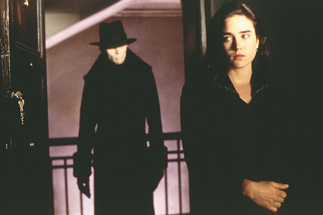|
|
Are You With Us?: Dark CityBy Shalimar SahotaSeptember 10, 2009
When it came to marketing the film, New Line Cinema produced a great poster (with a cool tagline), and an impressively shambolic trailer, which is practically a music video for Hughes Hall's amazing song Sleep Now, from the film's soundtrack. Presenting a montage of stunning clips with no dialogue whatsoever, it offered little indication as to what the story was and merely added to the confusion. This might explain its dismal performance at the box office. Opening in February 1998, while Titanic was still topping the charts, it made a new entry at #4 with a modest take of $5.5 million. Despite positive reviews, it dropped considerably after that. With a budget of $27 million, it managed only $14.3 million in the US and $12.8 million internationally. It may not have been quite the box office breakout at the time, but over the years it has gathered quite a following, with author Neil Gaiman and critic Roger Ebert being such huge fans they even make appearances on the DVD. Ebert recorded a commentary for it. To celebrate its tenth anniversary a director's cut was released on DVD and Blu-Ray last year. This edition has over ten minutes of additional, extended and even altered scenes, such as the removal of the opening narration, which Proyas explained was forced upon him by New Line Cinema, explaining a number of plot twists for simpletons like me. Proyas may only have six feature films to his name, but despite whatever criticism comes his way, he's one of the few directors that continues to make original work. Dark City clearly isn't appropriate for anyone with an affliction to intelligence, but then neither is having a baby. It's an ambitious, mind-bending mystery, which is essential if you haven't seen it, and if you have, then give the director's cut a go.
[ View other Are You With Us columns ]
[ View other columns by Shalimar Sahota ]
[ Email this column ]
|

|
|
|

|
Friday, May 3, 2024
© 2024 Box Office Prophets, a division of One Of Us, Inc.


